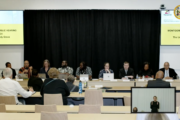Born with a life-threatening congenital heart defect in 2010, Chance Bond underwent three open-heart procedures by the time he was barely 2 years old. Each time, Chance was the tiny focal point in an operating room crowded with specialists working to repair his defective heart.
Children with hypoplastic left heart syndrome, or HLHS — the condition Chance was born with — can do very well, leading full lives with family and friends, school and play. However, they never really outgrow their condition.
[See: 10 Concerns Parents Have About Their Kids’ Health.]
With HLHS, a series of three surgeries is used: the Norwood, the Glenn and the Fontan, all named after the cardiac surgeons who developed them.
Chance was 9 days old when he had the Norwood surgery at the Monroe Carell Jr. Children’s Hospital at Vanderbilt in Nashville, after a rapidly arranged transfer from the community hospital near his family’s home in Byrdstown, Tennessee.
Chris and Amanda Bond conceived Chance, their third child, soon after Amanda had surgery to “untie” her Fallopian tubes. However, her levels of progesterone — a hormone essential to maintaining a pregnancy — soon fell dangerously low. The first ultrasound revealed a blood clot inside the womb, which put Amanda on bedrest for 14 weeks. She developed high blood pressure and had to wear a heart monitor.
Throughout the pregnancy, results from multiple ultrasounds and noninvasive fetal stress tests to monitor the baby’s health were all normal. But then Amanda went into preterm labor at 30 weeks. “We didn’t think I was going to make it to my 38-week C-section,” Amanda recalls. “But we did.” After more bedrest and doubt, the baby was born, and apparently thriving — hence the name Chance.
That all changed the next day, when Chance was taken in for a seemingly routine circumcision. Awaiting his return in their hospital room, his parents heard a knock at the door, followed by the entry of the health care team.
Medical discussions that start with “I need you to sit down” rarely bring good news. The team described a frightening sequence of events, beginning with a nurse spotting Chance turning blue after the procedure. Suspecting a possible heart condition, the staff immediately consulted with experts at Vanderbilt, did emergency testing and started Chance on life-saving medication to prevent circulatory failure. A transfer to the major children’s heart center at Vanderbilt, about 120 miles away, was already in the works.
Chance’s condition was stabilized, but his first week of life was all the time his parents had to absorb the shattering news, learn what they could about congenital heart conditions and make treatment decisions with the highest possible stakes.
Hypoplastic left heart syndrome is a single-ventricle heart defect — meaning there’s really only one pumping chamber to the heart, explains Dr. J. William Gaynor, a pediatric cardiothoracic surgeon at Children’s Hospital of Philadelphia, who was not involved in Chance’s care.
“In the normally developing child and adult there are two pumping chambers: the right ventricle that pumps to the lungs, and the left ventricle, which pumps to the body,” Gaynor says. “In hypoplastic left heart syndrome, the left ventricle is underdeveloped and essentially unusable.” The aorta — the vessel that sends oxygen-rich blood from the heart to the body — may also be poorly developed and too small to work properly.
Congenital heart disease is sometimes diagnosed during pregnancy. But many cases, like Chance’s, are discovered after the baby is born. Often, parents are completely blindsided by the revelation and doctors strive to be sensitive when making it.
“We would have a very long conversation,” says Dr. Charles D. Fraser Jr., surgeon-in-chief and chief of congenital heart surgery at Texas Children’s Hospital. “Anytime you have a family that gets this shocking news, we want to spend a lot of time with them to try to help them understand as much as they can,” says Fraser, (who was not involved in Chance’s care).
Fraser reassures parents that severe congenital heart disease is not something they caused or that could have been prevented. “I do always start the conversation with the blunt reality that without treatment it’s a uniformly fatal condition,” he says. He often describes how much he’s seen surgery improve in the course of his career. When he was a medical student in the early 1980s, he says, he recalls a single paragraph in a textbook on HLHS, which described the syndrome as “hopeless.” Today, as outcomes keep improving, five-year survival rates after successful staged surgeries are about 70 percent, according to conservative estimates. Even so, Fraser says, “We’ve made enormous progress but there’s still a lot we don’t know.”
He helps parents understand children’s anatomy, unique factors affecting their infant’s risk, the stages of surgery and medical follow-up and the lifelong commitment to cardiac care they will face. “Then I want to offer them hope,” Fraser says. “So I tell them about some of the happy stories that I’ve been involved in and that we’ve seen in our field.”
The first surgery for HLHS, the Norwood, is the most complex and riskiest. “Of course, my first question was, ‘What is his chance for survival?'” Amanda says. The response was: “He has a 50-50 chance.” Until his tiny chest was opened, the surgeons wouldn’t know the extent of Chance’s heart defect.
Chance made it through surgery, although complications arose. A few days later, as he was weaned off the ventilator, his parents witnessed a frightening episode of seizures. But he was treated and began his recovery in the pediatric critical care unit.
Bit by bit, Amanda began reclaiming her role as Chance’s mother. Small tasks took on great meaning.
In pediatric intensive care, Amanda says, “You don’t realize how precious it is to change a diaper, when you can’t do anything like that. But when you’re in that situation and you’re so helpless and everything’s going on, you still have control over some things. ‘I can pick out their blanket. Maybe check their temperature.’ It was a big deal for me.”
As the nurses took care of her baby, Amanda watched, asked questions and learned more complex tasks hands-on, like how to insert Chance’s feeding tube through his nose. Although the possibility of placing a long-term feeding tube was discussed, she said no — her son would be able to gain weight without it.
[See: When Health Treatments Go From Hospital to DIY.]
A month after his hospital stay began, Chance went home with a sleep apnea monitor and a device to measure oxygen levels in his blood. A new phase of life began for Chance, his parents and his siblings, then ages 9 and 3.
This is called the “interstage” period — when babies with congenital heart disease leave the hospital for home. “It’s a critical time,” Gaynor says. “It used to be a very risky time. As many as 10 to 15 percent of babies died suddenly at home.” Now, he says, most centers have instituted interstage-monitoring programs for high-risk babies at home.
“Those programs have been successful in improving growth in babies, because nutrition is an issue. And also in decreasing the risk of interstage death,” Gaynor says. Parents in this situation should make sure this type of program is available to them.
Chance did well at home, where he returned once again after six days in the hospital for his second surgery at just 4 months old. With this milestone achieved, and with guidance from the hospital’s speech-language pathologist, with expertise in feeding issues, Amanda started Chance on bottle-feeding.
Just after Chance turned 2, he underwent his third planned surgery. Since then he has been developing on track — walking and talking on schedule, reading and sounding out words “like a whiz,” his mother says.
Now 6 years old, Chance just graduated from kindergarten. “He plays T-ball and is doing every single thing he wants to do,” Amanda says. “And we’ve not had to set any limits on it as of now.” At times, she says, his lips might look a bit purple and she’ll have him sit for second to catch his breath.
After the Fontan surgery, “Most kids tend to do well in terms of growth and cardiac function,” Gaynor says. “For probably, not all, but most, for 10 to 15 years, until their late teenage years and early adult years.”
Then, unfortunately, Gaynor says, the risk of problems related to the surgically rerouted circulation increases. Poor growth, liver problems, malnutrition and a form of bronchitis can occur. For many, as young adults, the future may hold heart failure and even heart transplant, although this is an infrequent, last-resort treatment.
[See: 10 Seemingly Innocent Symptoms You Shouldn’t Ignore.]
Amanda and Chris Bond are fully aware of these issues. “Chance’s surgeries were not a fix — they only are to help give him the best quality of life for now,” Amanda says. “At some time, he will need more intervention, and that is something that I try not to focus on, because right now, the kid is living like a ‘normal’ kid and we are a typical crazy family of five.”
More from U.S. News
10 Concerns Parents Have About Their Kids’ Health
14 Things You Didn’t Know About Nurses
7 Reasons to Call Off a Surgery
Chance’s Story: When Newborns Face Open-Heart Surgery originally appeared on usnews.com







